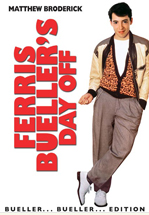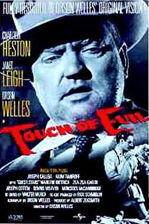Ferris Bueller’s Day Off
 Before writer/director John Hughes launched the enormously successful Home Alone series
and made himself a very rich producer, his stock and trade was the teenage comedy. The movies
of this period are well known and run the gambit from the hilarious farce Sixteen Candle to
maudlin The Breakfast Club. Most well known in this series, of course, is the glorious Ferris
Bueller’s Day Off and is the subject of this review.
Before writer/director John Hughes launched the enormously successful Home Alone series
and made himself a very rich producer, his stock and trade was the teenage comedy. The movies
of this period are well known and run the gambit from the hilarious farce Sixteen Candle to
maudlin The Breakfast Club. Most well known in this series, of course, is the glorious Ferris
Bueller’s Day Off and is the subject of this review.
First full disclosure: I am a huge John Hughes fan. I think his writing is terrific, his comic timing is good, and he excels at musical editing. I even find redeeming qualities to the Home Alone series; I should say, at least the first one.
That being said, I make a modest proposal that Ferris is one of American film’s recent finest comedies. The main reason I state this is that it isn’t truly a teenage comedy - it is a vaudeville masquerading as a teenage comedy. Why else would he team Matthew Broderick and Alan Ruck (who was 29 at the time), both with theatrical credits to their name? They (with the rest of the cast) throw their “shtick” around the screen to create an entertaining and funny story.
The plot is well known but repeated here for review. Ferris wakes up on a glorious Chicago spring weekday and cannot bring himself to go to school. He gets his reluctant best friend, Cameron the hypochondriac, and his girlfriend, Sloane, to join him in playing hooky. First he must convince his parents that he is sick, notify the school of his absence, and obtain transportation to downtown Chicago. Confounding our truants (and equally confounded by!) is the pompous Vice-Principal Ed Rooney and Ferris’ sister, Jeannie. The two pursuers are played by Jeffrey Jones (Amadeus) and a pre-nose-job Jennifer Grey. (Grey does a short but hilarious scene with a very burned-out looking Charlie Sheen.) The movie is rounded out by two extremely clueless parents (the father runs into his truant son in downtown Chicago not less than four times without noticing him once.)
At the core of the movie is a wisecracking Broderick, who skirts effortlessly through the movie (as we assume Ferris does through life), always one step ahead of the authority figures, who can be easily mocked without their notice. Once again, I say that Broderick isn’t a teenager or even playing one, he is playing the ideal version. His performance is spiced with gags, bits, monologues and looks to the camera. The hijinks are well controlled by Hughes, to avoid a descent into silliness as easily demonstrated by Jim Carrey numerous times. Ferris is letting the audience in on the joke at the expense of any particular version of authority that is at hand. This then becomes John Hughes’s great thesis of his teenage comedies-don’t let The Man (or the popular kids) get to you.
Robert Millholland
Madison, WI
Madison, WI
Touch of Evil
 Touch of Evil was one of Orson Welles’ last chances
to work in Hollywood-and an accidental chance at that. After Welles
disappointing history with the major studios following his audacious and
mesmerizing Citizen Kane, culminating with the disastrous handling of
The Magnificent Ambersons, Welles found harbor in European productions,
either as director, actor, or both. In 1958, Welles came to Hollywood for
another acting job, this time as the corpulent, corrupt police detective in
Touch of Evil. The story has it that Charlton Heston, the male lead of
Touch of Evil, upon learning of Welles involvement assumed that Welles would
direct. To appease Heston, producer Albert Zugsmith gave Welles the directing
job. The resulting film, its origins as a Whit Masterton pulp novel, is no less
the product of a genius. It is a stunning visual masterpiece.
Touch of Evil was one of Orson Welles’ last chances
to work in Hollywood-and an accidental chance at that. After Welles
disappointing history with the major studios following his audacious and
mesmerizing Citizen Kane, culminating with the disastrous handling of
The Magnificent Ambersons, Welles found harbor in European productions,
either as director, actor, or both. In 1958, Welles came to Hollywood for
another acting job, this time as the corpulent, corrupt police detective in
Touch of Evil. The story has it that Charlton Heston, the male lead of
Touch of Evil, upon learning of Welles involvement assumed that Welles would
direct. To appease Heston, producer Albert Zugsmith gave Welles the directing
job. The resulting film, its origins as a Whit Masterton pulp novel, is no less
the product of a genius. It is a stunning visual masterpiece.
Set on the US/Mexican border, the film begins with a truly amazing tracking shot that lasts over two minutes without a cut. This shot is finally interrupted by a car exploding, and we are propelled into the story-a murder mystery with implications on both sides of the border. The bomb has killed a wealthy, American businessman and his striptease club paramour. The bombing is witnessed by Ramon Miguel ‘Mike’ Vargas (played by Charlton Heston), an important anti-drug law enforcement officer in the Mexican government. Vargas gets an up close look at the police procedure of a one Capt. Hank Quinlan (Welles.). As investigation of the murders proceeds, we see the diametric circumstances of Quinlan and Vargas. Quinlan’s world has long away spun off its axis, dragging his corpulent, cane yielding body through his police work. Vargas, newly married to an American (Janet Leigh) is a rising star in anti-narcotics. But he has one concern-he is due to testify against a drug lord and the rest of the gang is after him. Through twists and turns that I won’t list here, a clash of wills (and ethics) is set up between Vargas and Quinlan. And soon, Vargas’ world will spin off its axis.
The style of film is hard to categorize. It is part film noir, borrowing many of the lighting techniques of that genre. Many of the scenes are at night, with severe noir backlighting. There are low-angle shots that emphasize an otherness of the characters. Shot from below, Welles rotund frame, in a trench coat on the Mexican border, emphasize his disheveled appearance. The cityscapes are dimly lit and have a desolate, alienating appearance. Oil derricks intermingle with run-down bars and hotels. One of the daylight scenes takes place in a deserted motel in the midst of empty sagebrush country. Despite all this, the film is also cleverly funny-either as a send-up of the crime genre or in Quinlan’s jaded outlook on life, perfectly played by Welles.
The screen is populated with the three major characters of Welles, Heston and Leigh, but a supporting cast that includes some notable cameos. We have Zsa Zsa Gabor as the owner of strip club. And there is a cameo from Marlene Dietrich as the owner of a brothel that contains the bloated and drunk Quinlan. When he asks her to read his fortune, she replies, “You haven’t got any.” Look also for Akim Tamiroff as the Latin Caesar Uncle Joe Grandi, whose character, as Janet Leigh says, has seen too many gangster movies. There is also Ray Collins (of Perry Mason) as an assistant D.A. Watch also for an uncredited, gender bending cameo by Mercedes Cambridge as a member of the Grandi gang.
Bonus review: Those of you who have seen Ice Age might recognize the story. It comes from an oft-filmed play The Three Godfathers. It has been filmed a total of five times, no less than twice by John Ford. The 1948 version stars John Wayne. Three desperate criminals must take care of an orphaned baby in the middle of the Mojave Desert. Sound Familiar?
Robert Millholland
Madison, WI
Madison, WI
